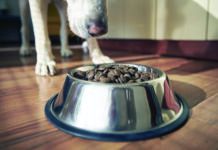By a Whisker
A dog’s whiskers play distinct roles in his safety and understanding of his world.
“All Dogs Must Be Leashed” Applies to Yours, Too”
You know how certain state parks and nature reserves post signs telling dog walkers to keep their pets leashed, yet some people don’t? They may figure their dog is well behaved enough not to cause trouble, or they know the park is large enough that they can choose trails that keep them away from other people and other pets and thereby avoid behavior problems. But the dog should be leashed, anyway. The rules are not just about behavior toward people and other dogs.
Is Your Dog’s Food Bowl Bacteria-Free?
Measuring bacteria levels on 32 household surfaces, researchers have found that pet food dishes have the ninth highest level of contamination. The good news: taking the proper precautions can reduce bacterial counts by 90 to 99 percent. The main precautions:
Do You Look Like Your Dog?
Twenty years ago, sociologist Gini Graham Scott, PhD, wrote a book called Do You Look Like Your Dog? She got the idea for it when she was at a dog show and observed dogs and their owners sitting next to each other. Since then, another book has come out with the same title. Which begs the question: Do you? Research suggests you very well might.
Between the Raindrops
Q: My dog absolutely hates to go out in the rain. It’s a tug of war every time the drops fall. But she needs to relieve herself. Anything I can do on rainy days short of dragging her?
Chronic Pain Causing Sleep Loss? Rx: Take One Dog to Bed with You
It might seem that if you suffer from chronic pain that keeps you up at night, the last thing you should do is let your dog in the bed with you. Dogs take up space. They wake up about four times as often at night as people. They fidget.
Avoid Canine Frost-bite and Other Cold Weather Hazards
It’s a common belief that dogs are more resistant to cold weather than people because of their fur, but that’s not true. Granted, longer-haired and thick-coated dog breeds like huskies and other dogs bred for colder climates are more tolerant of cold weather than dogs in general. But even dogs that don’t complain or don’t seem to mind are susceptible to frostbite and hypothermia. When the weather is extremely cold, shorten your outdoor time with your pet.
Urinating On Purpose Versus Urinary Incontinence
If you see your dog posturing to urinate indoors, it could be a behavioral issue. She may be upset or confused. It could also be a medical issue like a urinary tract infection, diabetes, or Cushing’s disease. Dogs really try to wait until they get outside, but those conditions sometimes increase urgency to the point that they simply can’t wait.
But if urine trickles out without your dog trying to go, perhaps while she is sleeping, it’s likely urinary incontinence. You might find a little puddle at the spot when she wakes up and walks away, or perhaps urine on her rear quarters or her side.
If Your Vacuum Doesn’t Have a HEPA Filter
A vacuum with a HEPA filter is one of the best bets for ridding your home of the hair and dander shed by dogs—which for some people causes allergic reactions. HEPA stands for “high efficiency particulate air,” and tightly woven HEPA filters can keep just about all small, inhalable irritants from spewing back into the air as you vacuum—not just dander but also dust and other airborne particles. Make sure filtration efficiency is at least 99.97 percent and that the particles retained are as small as 0.3 micrometers. The label should guide you, and you can also ask the manufacturer.
When You Turn Down the Thermostat Before Leaving the House But the Dog Stays...
Dogs, like people, can become uncomfortably cold in winter weather, even if they don’t show it. Thus, if you leave your dog home alone for several hours but turn down the thermostat to save on energy bills, make sure your pet has a fuzzy dog bed with a blanket. If she gets cold enough, she can even pull the blanket over herself with her teeth.
How to Engage Your Dog in a New, Fun Activity When You Don’t Have...
Have you ever invited your dog to walk on a low wall while the two of you were on one of your daily outings together or perhaps make her way along a ramp? If so, then you were having her practice dog parkour. It’s derived from a training program used by military personnel to navigate obstacle courses.
Make a Fist…And 5 Other Urban Myths About the Best Way to Approach an...
“Make a fist.” How often do we hear people tell their preschooler to close their hand into a fist when the youngster wants to pet a dog they don’t know? The belief is that making a fist is less aggressive than going straight to petting and less threatening than an open hand. Also, the thinking goes, making a fist gives the dog an opportunity to get to know the person by sniffing them before there’s any actual body contact.
















